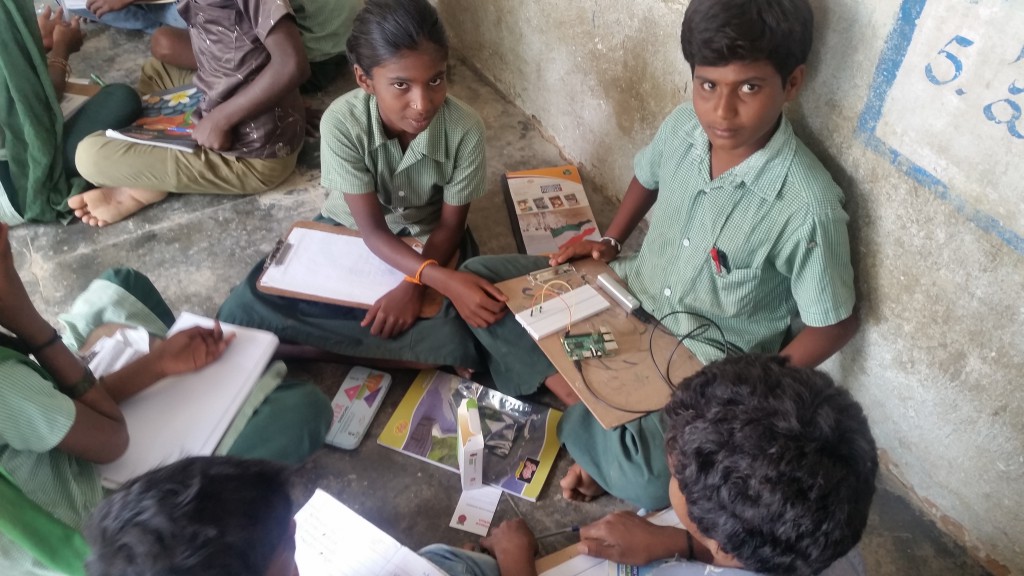Interview with Moni Gupta
Co-founder of Mobile Education for Smart Technology
Location: India / Cambridge, UK
“The same thing they are learning in their books they can explore with this technology and build up more creativity”.
Today, Moni Gupta is a PhD student in chemistry at the University of Cambridge. But she remembers her time as a child in India, where she had limited access to computers in school. “There was a lack of resources and lots of things I wanted to do,” she recalls.
So she sees herself in the students she interacts with through Mobile Education for Smart Technology, a nonprofit organisation she co-founded. The project introduces village boys and girls to computers, in some cases for the very first time. “The same thing students are learning in their books they can explore with this technology and build up more creativity,” she says.
Smart Villages challenges Cambridge grad students
The group started in January 2015, when the Smart Villages Initiative challenged Cambridge graduate students to come up with a project that would contribute to rural development. Gupta says her mind went straight to the lack of computers in Indian schools, and she found others who wanted to focus on the same issue. That group formed the core of the project.
Next, Gupta recruited two partner organisations. The first, the Cambridge-based Madanyu, had developed the idea of using a tiny, open-source computer called Raspberry Pi as an educational tool. The simple computers are about the size of a deck of cards and connect easily to devices like monitors, keyboards, and cameras. For Gupta’s group, Raspberry Pi units offered several advantages: they cost only US$40 to US$65 each; they were sturdy and needed little maintenance; and they ran open-source software that village schools could use for free. The workers at Madanyu trained Gupta and her colleagues in how to use the systems.
The other partner, Agastya, was based in India and ran a sprawling 170-acre campus in the southern Indian province of Andhra Pradesh. Agastya specialized in rural education, and offered to host the computer classes Gupta’s team planned to run.
Reaching the students
In September 2015, Gupta and four other team members arrived in Andhra Pradesh to conduct a two-week programme. They brought 37 Raspberry Pi units purchased with a grant of about US$4,000 from the Smart Villages Initiative. Half of the team taught classes at the Agastya campus, while the other members traveled to a nearby village and taught from a classroom in the local school. Then, during the second week, the team members focused on training local teachers, who led the classes themselves.

Although the Raspberry Pi computers were simple, students were able to explore a wide variety of tasks, including word processing, mapping, and writing code in the Python language. The students also got an introduction to scientific databases, in a project where they recorded and graphed the results of repeated bottle-rocket launches.
“The students were really motivated to learn,” Gupta says. “The whole class was running, everyone was shouting”.
Challenges along the way
Because boys are often raised to be more outgoing than girls in the local culture, Gupta found that they often approached learning more aggressively, while the girls tended to stay quiet. Her team addressed this by organizing the students into groups that contained both genders, and setting up lessons that forced all the students to participate. “We tried to empower both at the same time and build confidence among the girls,” Gupta said.

Another challenge the team faced was the technical limitations of rural villages. The electrical supply had no grounding system, which caused short-circuits and even electrical shocks. While Gupta says shockproof plastic covers for the computers might help, she thinks making the system mobile would be a better solution. She imagines a bus with its own solar power supply, which could bring the computers to different villages for class.
Agastya has operated mobile classrooms in the past. But Gupta says they are no longer operational, and that significant problems need to be solved to run them sustainably. For example, extreme heat and bumpy rides down unpaved roads can damage computer equipment, so the vehicles would need customisation and reliable air conditioning. “It’s a technical problem to build, and it needs funding,” Gupta says.
Human resources presented a third challenge. Of the six to eight teachers originally trained by Mobile Education for Smart Technology in 2015, only one remains at Agastya today. Agastya continues to use the Raspberry Pi units on its campus, but with just a single staff member working on the project locally, the scale of the project is small.
Gupta points out that the project is still in its initial stage, but believes it is full of potential. In five to 10 years, she’d like to see it more completely realised, with fully functioning mobile classrooms. She’d also like to see the same programme expanded to three or four different regions of India.
Work in that direction is already underway, and the group will conduct another series of classes soon at Agastya’s second campus in the town of Hubli, in the Indian state of Karnakata.
—James Trimarco, Writer and researcher




